There may come a time when your company will be faced with a PR crisis. In that situation, it’s important to remember that, while inevitable, it’s not unstoppable or unmanageable. Your crisis communications strategy is often what dictates how a crisis is going to play out.
Make no mistake: how you handle a crisis can and will affect your brand reputation and image. How people feel about your brand may change. Whether it is a change for good or bad depends on your crisis response.
💡 Read Crisis Management 101: How to Save Your Business When a Crisis Strikes
To handle the situation well, it’s crucial to anticipate possible crisis scenarios. That means no scrambling for a response once the crisis hits, but already having one ready to go.
It means being proactive about your crisis communications strategy and performing a premortem analysis to anticipate weak points. It means developing a crisis communications strategy and plan.
That way you won’t make rushed decisions once the crisis hits. Instead, you’ll be able to reduce the response time and make informed decisions about how to approach the situation.
Effective crisis monitoring and communication can minimize the damage to an individual, organization, or company when facing challenges. That’s why it’s important to develop a structured and informed strategy to reduce the damage
A way you can considerably improve your crisis communications strategy is through media monitoring.
More precisely, there are 4 ways media monitoring can help you anticipate and manage a PR crisis.
1. Detecting a Crisis
Nowadays, social media platforms are the birthplace of most crises. The customers have the power and their “outrage” on social media can cause many problems for brands. Whether it’s a video of a rude employee, a broken product, or something else, the minute it’s posted online, it has the potential to escalate.
Take a look at United Airlines, for instance. Back in 2017, due to an overbooked flight and to make room for four crew members, a passenger was “chosen” to be removed from the flight. After he refused, officers then forcibly and violently removed him from the plane. The whole thing was captured by the other passengers and posted to social media from multiple sources. Cue – the crisis.
People were rightfully outraged by how the situation was handled and outright started boycotting the airline.
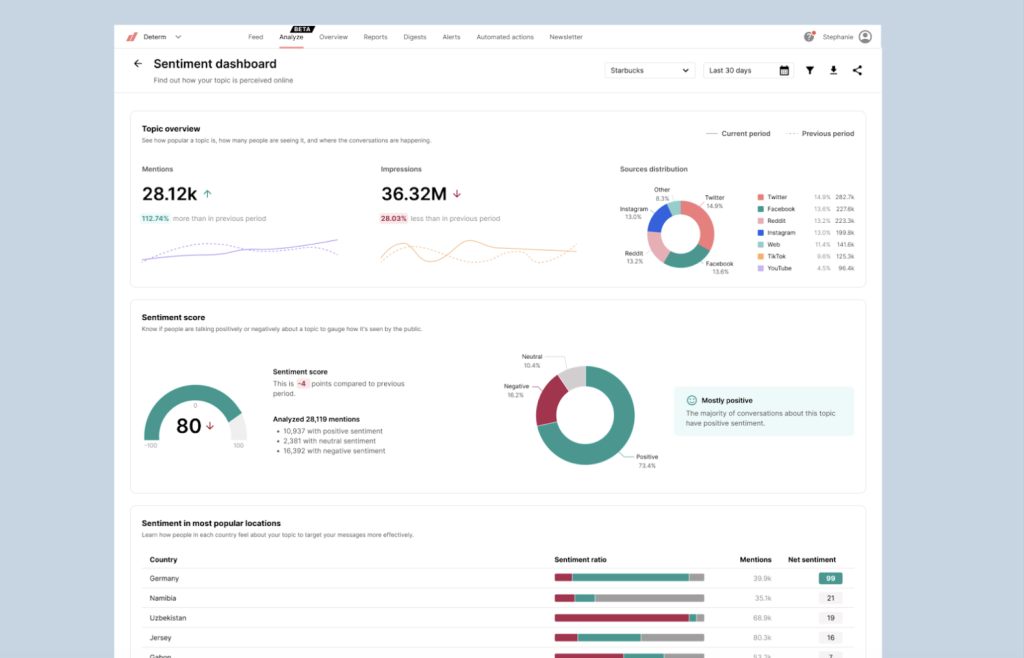
These are the kinds of situations where media monitoring can help you discover the problem, but also better manage and overview the developing situation.
Read Proactive vs. Reactive: 5 Effective Crisis Response Strategies
Media monitoring can set you up for successful crisis resolution
If you don’t notice the problem right away, it can just end up getting bigger. The faster your reaction time, the higher are your chances of success. If your response is delayed, your customers will think that you don’t care. A late response can be met with skepticism and belief you’re only trying to save face.
Additionally, what matters is the kind of response you give. Make sure your response is thoughtful, empathetic, and that you address your customer’s issues head-on.
This is how media monitoring can help you.
If you’re closely monitoring your brand and related topics, you’ll be able to see every time someone mentions your brand online. Regardless if they tagged you in the post or not.
For instance, if a video of a rude employee is posted online, you’ll know right away. It’s sort of similar to detecting the patient zero. You want to pinpoint where the crisis originated, so you can mitigate it before it spreads like a wildfire.
Read 10 Steps to Manage Negative Online Reviews
3 key features especially useful in detecting a crisis
Alerts
By turning on the alerts feature in your media monitoring tool, you get notified every time someone mentions your brand. What’s more, real-time alerts will let you know when you’re mentioned in real-time. This will give you the opportunity to react immediately if you’re mentioned in a negative context, and save your brand image from a potential crisis.
Determ has 2 kinds of alerts – smart and spike alerts. Smart alerts are notifications for every mention that matches a specific filter criteria. Spike alerts, on the other hand, are notifications that you get once there’s an increase in the amount of mentions for a specific topic.
In addition, Determ offers Net Sentiment Spike Alerts which are triggered when sentiment around a specific topic related to their brand significantly shifts, enabling you to identify potential crises before they escalate.
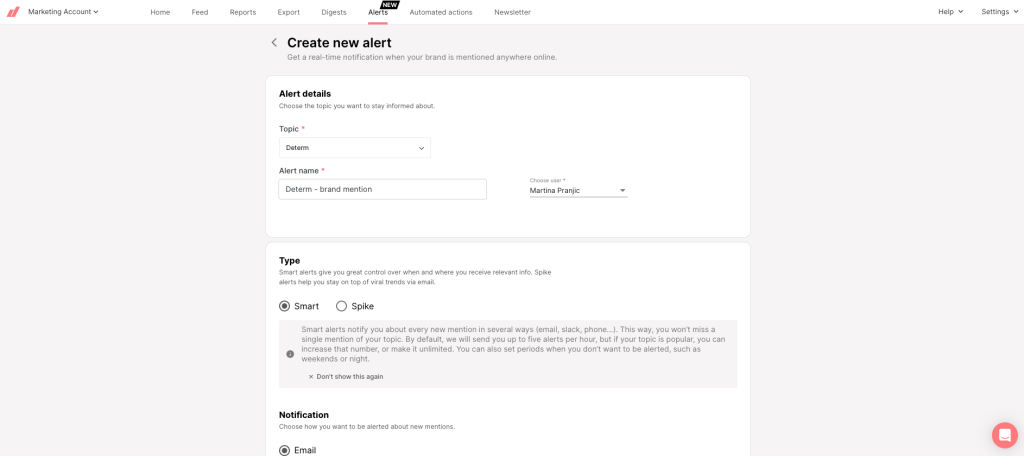
You can take a deeper dive into the spike alerts through the Spike Alert email. It not only notifies you of trending topics but also highlights posts that may have triggered the increase in mentions. This feature provides immediate context, empowering you to take action or refine your strategies. In addition, the Spike Alert dashboard comprises a range of informative graphs and a concise Synthia summary for an in-depth analysis of the situation.
Digests
This feature provides you with an overview of your mentions on a daily, weekly, or monthly basis (or you can customize them). It helps you regularly keep an eye on your online presence and reputation.
Automated Actions
Automated actions are a Determ feature used to automate the process of assigning tags and sentiment to your mentions. Rather than browsing through your mentions and manually adding a tag and/or changing the sentiment, the media monitoring tool automatically does it for you.
Here’s how they work:
- Enter keywords, authors, or websites that will trigger an Automated action.
- Choose an action that will be triggered: adding a tag, setting a sentiment, or both.
- Apply to selected feed(s) or globally for your organization.
This can be exceptionally useful when detecting a crisis. Let’s use an airline as an example again. If you want to keep track of situations that may potentially present a problem for your brand reputation, you can easily do it using this feature.
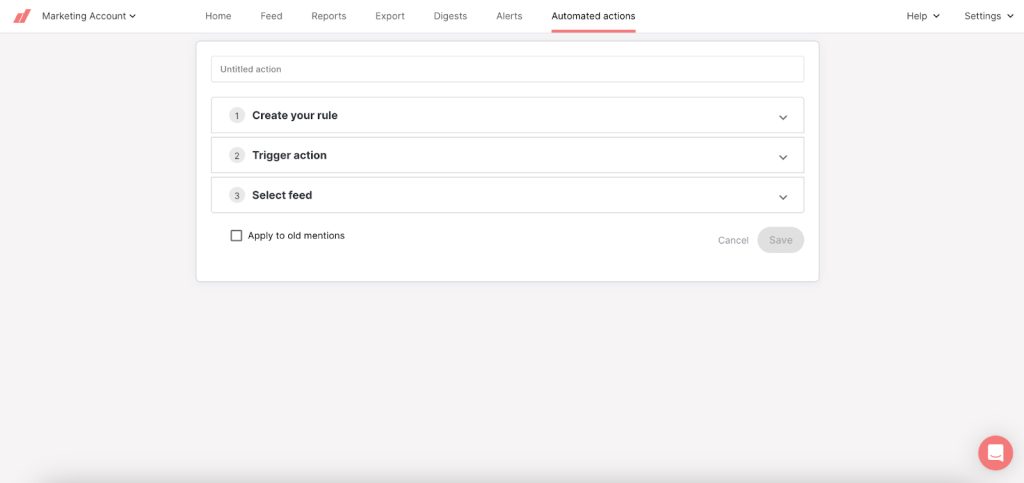
Let’s say you’ve identified your key pain points and you have your brand mentions grouped into these three tags: flight delays and cancellations, overbooked flights, in-flight service. This means that all your brand mentions about flight delays go into the Flight delays & cancellations tag, or all mentions about how your crew treats the passengers into the In-flight service tag.
For instance, to make sure none of the mentions escape your In-flight service tag you can automate the process using Automated actions. Simply enter related keywords (e.g. rude, bad service, unprofessional…), set the sentiment to negative, and select the In-flight service tag. This will make it so that every mention that contains keywords rude or unprofessional automatically gets tagged as negative and grouped under the In-flight service tag.
This will help you better organize your brand mentions and easily detect any developing issues.

2. Monitoring Brand Reputation During a Crisis
Monitoring your brand reputation is always important but during a crisis, it’s a vital part of your crisis communications strategy. Remember how Dove had a reputation crisis after their commercial was described as racist? Or when Victoria’s Secret top marketing chief Ed Razek said some controversial things in an interview?
With media monitoring, you can easily track your brand’s online reputation. Reports provide you with the necessary information that will help you make better and informed decisions to get out of a crisis. And stay out.
Read 9 Vital Steps of Crisis Communication for Successful Outcome
Metrics that matter during a crisis
For example, our media monitoring tool Determ has a Word cloud chart used to detect the most common words people associate with your brand when they mention you online. In Dove’s case, it was the word “racist”. With this information, you’ll know what you did wrong and on which aspects to focus on in the mitigation process.
Read Discover New Information About Your Brand with Word Cloud
Additionally, you can use that information for a more precise overview of your mentions over a period of time and on different channels. When we analyzed Dove’s crisis, we took note of how many times Dove was mentioned in connection to racism:
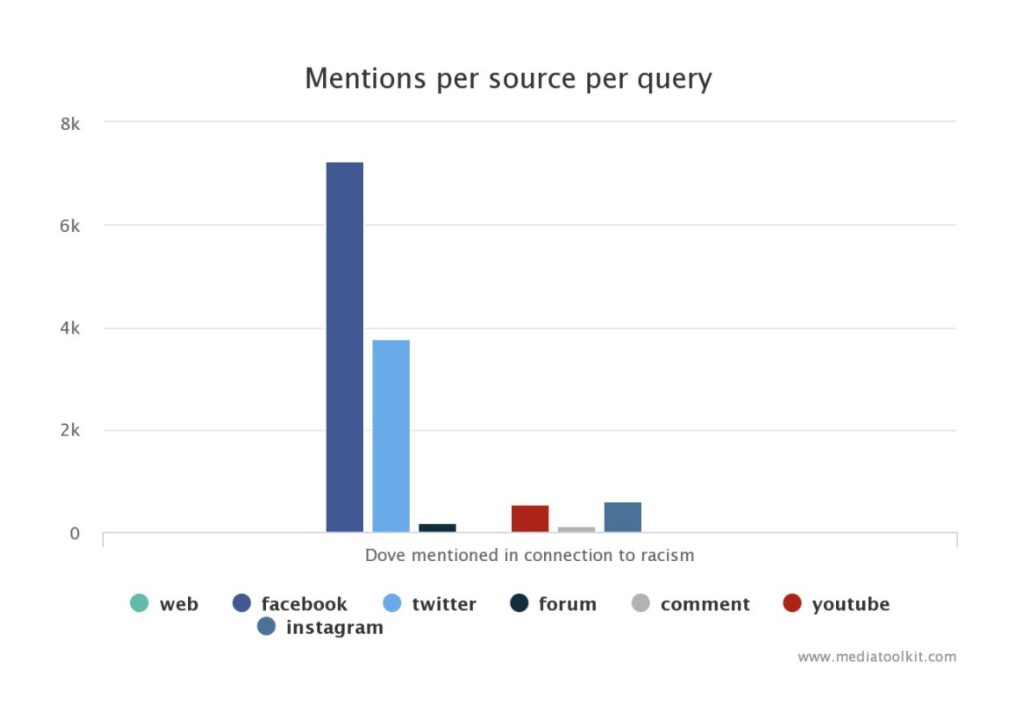
In the reports section, you can also find a list of the top 10 influencers that are the right fit for your brand. You can collaborate with them and with their help try to solve the crisis. Keep in mind that no one will rush to collaborate with a brand in crisis, so make sure you present a constructive, well thought out plan to them.
Reports also provide you with an overview of channels people are using to talk about your current situation.
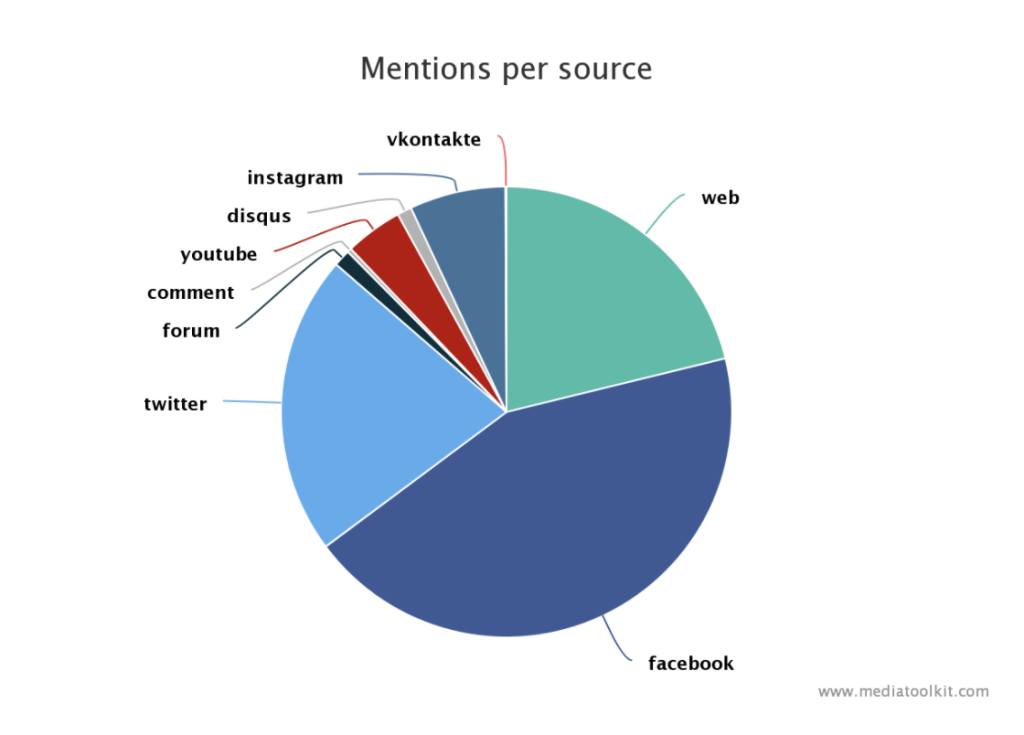
With this information, you’ll know on which channels to focus your response so your message actually reaches the target audience. Otherwise, your getting-out-of-a-crisis plan is useless.
3. Monitoring Crisis Development
As important as it is to track your brand reputation during the crisis, it is equally important to follow how the crisis itself is developing.
You need to know if there are some additional potential problems you should address or if your efforts to mitigate the crisis are making an impact. By making custom reports you will be able to isolate the problem, focus on solving it, and learn from this experience so it doesn’t happen again.
For instance, sentiment analysis allows you to track whether the public reaction is still negative or if it’s moving towards a positive, or at least neutral sentiment.
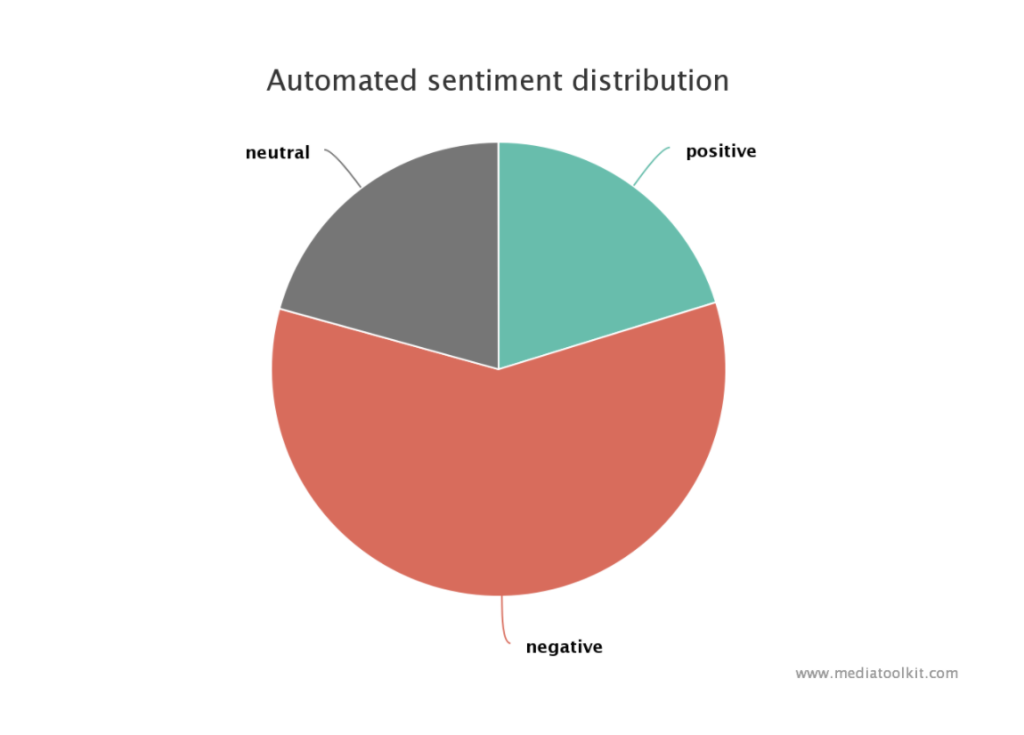
You can choose an automatic, effective, or manual sentiment. The automatic sentiment is not 100% correct because the computer can’t recognize sarcasm, for example. However, it’s a starting point. From there, you can go ahead and explore the scroll through negative mentions and make sure they’re classified correctly. If not, in Determ, you can manually change the sentiment.
Another thing you can do in Determ is use automated actions. For example, you notice that it’s marking all mentions with a certain word negatively, which you perceive isn’t negative. With automated actions, you can program the tool to automatically change the sentiment of all the mentions with that word.
Finally, the most effective sentiment is the combination of manual and automatic sentiment analysis. And in a crisis, if your sentiment continues to be negative, you should reevaluate your crisis communications strategy.
Read Top 5 Examples of Sentiment Analysis
4. Tracking Competitors’ Crisis Communications Strategy
Just as a crisis can happen to you, it can happen to your competitors as well. Track how they handle the situation and learn from them. That way, you won’t make the same mistakes they did. Or you may even pick up some good practices instead.
So, make sure you do a competitive analysis. Monitor how the crisis unfolds by tracking relevant keywords, i.e., the competitor’s brand name, related hashtags, and important players… You can see how your competitor responds to the crisis and how the crisis affects their brand reputation. Was their response quick enough? How did the audience react to it? Take notes of what went well and what didn’t, and use them to make informed decisions about your own crisis communications strategy.
Read Competitor Analysis: Stay Ahead of Competition with Media Monitoring
To Sum Up
Dealing with an unexpected crisis can be extremely challenging. In moments of crisis, the pressure rises, and the chance of making a mistake increases. By preparing for a potential crisis and using the right tools to manage it, you can get out of the crisis unscathed. Let valuable data be your helping hand during the crisis and a guide for better future decisions after the crisis is over.
If you’d like to find out more about how Determ helps you mitigate crises, book a demo call and our experts will show you how to use the platform to the fullest.